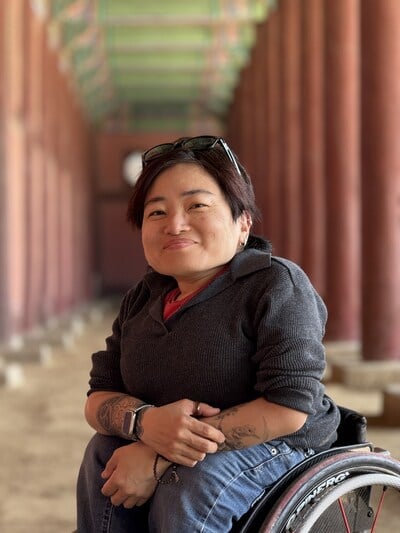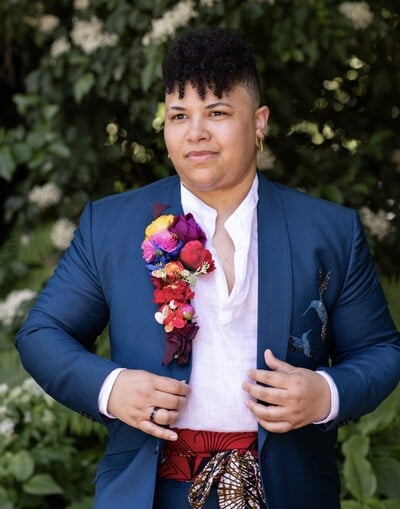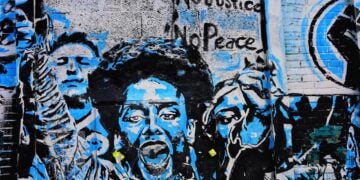This article was originally published by The Emancipator.
President Donald Trump’s administration has laid siege to DEI programs and public health infrastructure and stacked key Cabinet positions overseeing the country’s health and well-being with anti-science cronies. Health and Human Services Secretary Robert F. Kennedy Jr.’s regressive views on vaccines and neurodivergence echo eugenics ideals of a dark period in the nation’s history when those who were disabled were seen as defective, subjected to abusive medical procedures, and institutionalized.
People with disabilities were among the first threatened and harmed by the Trump administration’s dismantling of legal guardrails and federal policies ensuring equitable protection and services.
They were also the first to see this coming.
As celebrated disability rights Alice Wong says, people with disabilities are oracles, “someone who tells their truths in a hostile ableist world that does not believe you.”
To understand how we got here, and where we go from here, The Emancipator reached out to James Ian, an award-winning performing artist, writer, and graduate of Georgetown University Law Center; Rasheera Dopson, a digital storyteller and race, gender, and disability rights advocate; Mia Ives-Rublee, senior director of the Disability Justice Initiative at the Center for American Progress; and Evan Thornburg, a digital public health and bioethics communicator and city of Philadelphia health equity officer.
Their responses have been edited for length and clarity.
Frankie Huang: Both Nazi ideology and Jim Crow find their origins in eugenics, what are the social and material conditions that have contributed to eugenics making a return during this juncture in time?
“We are currently at this convergence of hyper-capitalism and hyper-masculinity during a mass disabling pandemic. Those in power felt they were losing their grip on power due to others finally gaining rights and we are right now seeing the impacts of that, like a death spasm.” — Mia Ives-Rublee, senior director of the Disability Justice Initiative at the Center for American Progress

“Eugenics has a very unique American history in its systemic execution along with spreading throughout the world. And, prior to the formal founding of eugenics, there is a long history of American pseudosciences exploring all kinds of race science and race-exclusive disorders or proto-eugenics, particularly as a way to morally legitimize the enslavement of kidnapped Africans for forced labor and the execution of genocidal practices and subjugation of Native Americans/Indigenous groups throughout the Northern Hemisphere.
Jim Crow was a foundational inspiration for Nazi Germany’s apartheid designs initially implemented toward Jewish and Romani communities. These conditions, concepts, theories, and practices were never dismantled, they were renamed, reconstructed under different theories, and have gone unspoken but persistently part of ‘common sense’ designs/ideologies.
With all that in mind, it does not surprise me that there is an open resurgence of this philosophy, especially when looking at historical patterns. The formal philosophy of eugenics peaked in popularity directly after the 1918 flu, a time when people obsessed over displaying superior health and fitness to cope with living through a global pandemic that was killing young adults in their prime.

Throughout medical history, eugenics and proto-eugenics ideologies/ideas relating to health, wellness, and the cause of hardship, frequently gained popularity, because they have been interwoven in an exceptional amount of our foundational education (separate but equal), religion (the “Curse of Ham” in Christianity), polarization in governance response (the Chinese Exclusion Act of 1882), and societal expected norms.
Without teaching with the intent to consciously reveal and dismantle the longstanding history of eugenics built into the foundations of our shared social beliefs, most of the general population draws on these problematic foundations to decide on answers for current conditions they feel negatively about.” — Evan Thornburg, a digital public health and bioethics communicator and city of Philadelphia health equity officer
How did disabled folks navigate life in an ableist and racist society before the passage of the Americans with Disabilities Act and Individuals with Disabilities Education Act granted them greater legal protection? What are some of those tactics that may need to be brought back now as protections and resources are being stripped?
“I want to nudge this question back a little further in legislative history to include Section 504 of the Rehabilitation Act of 1973, which was a major event in disability justice and disability activism, with an exceptional amount of coordination between activist groups to win this victory. Section 504 ensures equal access to education opportunities, but specifically, it legally states “nondiscrimination under federal grants and programs.” This is the first law protecting disabled people from discrimination but also guaranteed their ability to be included in any space that received or experienced federal funding.” — Thornburg
“Sadly, most disabled folks didn’t get a chance to navigate their lives before the passage of the Rehabilitation Act of 1973 and ADA. Disabled people were warehoused in congregate settings like almshouses, “insane asylums,” nursing homes, etc. Rarely did disabled people receive a proper education or a chance at employment. It wasn’t until injured veterans came back from war did we see significant movement. Around that time, we saw allyship between the disability community and Black community and an increase in mutual aid and cross-community collaboration/solidarity. These are the tactics we need to see today.” — Ives-Rublee
Personally, I’m not fearful about the future. I’m Black and disabled, and my people have always been oppressed and under attack in this country. We’ve survived and thrived for hundreds of years, and I plan on doing that going forward.
James Ian, award-winning performing artist, writer and graduate of Georgetown University Law Center
James Ian, award-winning performing artist, writer and graduate of Georgetown University Law Center
“Within the disabled community, there’s a growing consensus that we need to look to disabled elders to show us how to navigate spaces that are once again becoming unsafe or inaccessible.
Racism and ableism aren’t just individual attitudes or behaviors — they are systemic. This framing helps guide how we understand and resist systems, not just people, that perpetuate inequality.

One of the core strategies historically used — and one that we urgently need to revisit — is cross-movement solidarity, which is also one of the 10 Principles of Disability Justice. Disability justice teaches us that our liberation is bound up with others.
We see this principle in action during events like the 504 sit-ins, where disabled activists partnered with the Black Panthers and gained access to food, shelter, and safety. This wasn’t just charity — it was a model of solidarity across movements, built on shared resistance to state violence and systemic exclusion.
That same spirit of collaboration is critical now. As protections and resources are being rolled back, we must work across disability, racial justice, queer, trans, immigrant, and environmental movements. Disabled elders and advocates showed us how to generate resources, build networks, and push back without waiting for permission or approval from systems of power. That’s the blueprint we need to follow today.” — Rasheera Dopson, digital storyteller and race, gender, and disability rights advocate
“Tactics of resistance, activism, and advocacy that those in movements demanding disability justice have never left. An immense number of these activists are disrupting federal hearings on cutting Medicare and Medicaid through a myriad of radical techniques and means. Media, especially legacy media, mostly dismisses disability activism in a way that makes the rest of us believe that it must not be occurring, when in fact if this current group is successful in stopping these cuts to these programs, all of us will yet again have benefitted from their organizing and actions, but few of us will know. That erasure develops a regular passing generalization about human rights history that is the passive belief that justice was acquired by the (temporary) able, when in fact many exalted heroes are disabled folks.”— Thornburg
How are you navigating everyday life currently? How has your life changed now compared to even four years ago, in little and big ways? What are some of your fears with regard to what may come in the future?
“I think growing up a person of color and disabled, you know that at any time you could lose everything you have worked towards. Four years ago, I felt like my work was going to be temporary, that one day I would be able to do something outside of just ensuring a community could survive. I feel like I have even less control than I did before and everything feels very personal. As an immigrant, as a disabled person, as a woman, as a person who identifies with the LGBTQI person, I am struggling to keep my head above water and am just thankful to count each new day as another day I can fight back.” — Ives-Rublee
Unravel our paternalism as it pertains to seeing disability justice and rights as separate from ourselves. We are all temporarily able people, and therefore we are advocating for the rights that best serve us, all of us, as individuals and community members, not for a disparate group separate from us.
Evan Thornburg, a digital public health and bioethics communicator and city of philadelphia health equity officer
“Honestly, since January 20th, it’s been hard. The emotional burden of living in a time when racism and ableism are blatantly displayed on the news has been overwhelming. I’ve cried more this year than usual. It’s hard knowing that after all the work we do to educate, to prove our worth, a single administration can erase it without regard for our humanity. That’s infuriating.
And while my day-to-day life hasn’t drastically changed — I’m still a full-time Ph.D. student, still researching and writing — the fear is different now. The fear that your life’s work could be banned, silenced, erased. The fight to show up, be present, and push back takes a toll. It shouldn’t be this hard to be a disabled Black woman. But what’s happening politically is impacting all of us — some more directly than others.” — Dopson
“Personally, I’m not fearful about the future. I’m Black and disabled, and my people have always been oppressed and under attack in this country. We’ve survived and thrived for hundreds of years, and I plan on doing that going forward.” — James Ian, award-winning performing artist, writer and graduate of Georgetown University Law Center
As we hear of proposals from the likes of RFK Jr. about registering people with autism in a directory and baselessly blaming vaccines for causing autism, what is it that we should know so we can be effective allies?
“People need to understand how much misinformation, particularly around health, is based on racism and ableism. The only way to fight it is to actively fight back against misinformation and understand that disability is a normal part of the human experience.” — Ives-Rublee
“Issues that affect disabled people and other communities often affect people not belonging to those communities. At the end of the day, being an effective ally for disabled people and other oppressed people can mean that you’re being an ally to yourself. When RFK Jr. spews hate and talks about creating registries for people with autism, remember that it’s a slippery slope, and you or someone you love could easily be included in that registry. We are all people, and we need to look out for each other.” — Ian
“In an age where science and medicine are being villainized, we have to hold the line and speak the truth. Being an effective ally means doing more than posting online. It means confronting misinformation in your classrooms, your family dinners, town halls, and workplace conversations. It’s hard, but justice was never served by closed mouths. Don’t let their aggression force you into silence.” — Dopson
“What even the best allies are bad at is attempting to discuss disabling (an act of harm exacted on a person, often through accident, illness, or a literal or figurative act of violence/violent event), but instead ending up promoting ableism, particularly eugenics style talking points. There is a way to defend those in disabled communities without reducing the arguments used to pathologizing bodies. Simultaneously, defending disabled communities by announcing the amount of labor or accomplishment disabled folks are capable of is also reductionist and assigns less value to those who cannot do great labor or contribute to capitalism effectively/competitively.” — Thornburg
The public loves a certain kind of problematic uplifting disability inspiration porn. What kind of messaging would be effective in garnering the public’s empathy without giving into reductive narratives that rob disabled people of dignity and agency?
“Inspiration porn is based on ableism. So when we uplift inspiration porn, we uplift ableism. Instead of uplifting inspiration porn, we need to be uplifting the injustices happening and discussing ways to change it. We also need more diverse representation and narratives inclusive of disability to help decrease the novelty of disability.” — Ives-Rublee
“Learn the depth of identities your existing historic heroes lived with. Learn about Harriet Tubman’s ongoing narcoleptic events from a traumatic brain injury as a child. Read the biographical account of Brad Lomax, a Black Panther with multiple sclerosis who alongside his assistant Chuck Johnson participated in and provided care for the disabled activists who staged a three-week sit-in at the federal office building in San Francisco (leading to the implementation of Section 504.) Read about “pulguŭi chōngch’i”, the concept of “crip politics” in South Korea, particularly as it is interwoven with labor justice movements fighting the working conditions in the technology industry’s assembly factories. Unravel our paternalism as it pertains to seeing disability justice and rights as separate from ourselves. We are all temporarily able people, and therefore we are advocating for the rights that best serve us, all of us, as individuals and community members, not for a disparate group separate from us. Curb cuts are used by parents pushing strollers, Medicare and Medicaid are beneficial to gig workers, accessible public restrooms provide relief for smaller children and pregnant people, remote work supports familial caregivers, universal income supports those who are struggling to find employment. Disability justice provides dignity and agency to all of us.” — Thornburg
“When you actually listen to disabled people, you’ll find that most of us live in the nuance — in the everyday, not the glamor or pity the media prefers. We are fully human: with depth, with emotions, with desires. If we can normalize that without needing applause, we’ll begin to see and hear disabled people for who we are: a part of the human condition.” — Dopson
Learn more about third-party content on ZanyProgressive.com.





